ISSN: 1204-5357
ISSN: 1204-5357
| LINA WU, MBA Market Analyst, Hengtong Optic-Electronic Co., Ltd., Suzhou City, China Postal Address: 2F Block 8, Optic-Industry Park No.2288, Zhongshan North Rd., Wujiang District, Suzhou City, Jiangsu Province, China Email: linawu_1_30@foxmail.com |
| Ms. Lina Wu is a market analyst in Hengtong Optic-electric Co., Ltd., China. She received her master’s degree in Management Information Systems from Ajou University and earned a bachelor’s degree in Information and Computing Science from Changsha Science & Technology University in China. Her research interests include mobilecommerce, the business value of IT, and consumer relationship management. |
| MINCHOEL KANG, Ph.D Professor, Department of e-Business, Ajou University, Suwon, South Korea Postal Address: 206 Worldcup-ro, Yeongtong-gu, Suwon, 443-749, South Korea Author's Personal/Organizational Website: http://biz.ajou.ac.kr/biz/professor/professor06.jsp Email: mckang@ajou.ac.kr |
| Prof. Mincheol Kang is a faculty of e-Business Department in the School of Business, Ajou University, Korea. He received a Ph.D. in engineering science from Rensselaer Polytechnic Institute, Troy, NY, USA. His current research area is IoT, augmented reality, mobile commerce, etc. |
| SUNG-BYUNG YANG, Ph.D Assistant Professor, Department of e-Business, Ajou University, Suwon, South Korea Postal Address: 206 Worldcup-ro, Yeongtong-gu, Suwon, 443-749, South Korea Author's Personal/Organizational Website: http://biz.ajou.ac.kr/biz/professor/professor06.jsp Email: sbyang@ajou.ac.kr |
| Prof. Sung-Byung Yang is a faculty of e-Business Department in the School of Business, Ajou University, Korea. He received his Ph.D. from KAIST. He was a research fellow in the Desautels Faculty of Management at McGill University. His research interests include mobile commerce, online communities, social media and networks, knowledge management, and customer relationship management. |
| © Lina Wu, Mincheol Kang and Sung-Byung Yang, 2015 |
Visit for more related articles at Journal of Internet Banking and Commerce
This study proposes an integrated model of users’ intention to purchase paid smartphone applications. Focusing on individual-level perceptions of paid smartphone apps, it investigates the impacts of paid apps’ characteristics (perceived usefulness and perceived price), as well as their users’ personal (personal motivation and self-efficacy) and social (mass influence and peer influence) characteristics on users’ attitude toward paid apps, which in turn influence users’ intention to purchase them. The proposed research model was evaluated using data collected from 231 respondents through the structural equation modeling technique. The results showed that perceived usefulness, self-efficacy, and peer influence are critical determinants of users’ attitude toward paid apps, which can lead to users’ intention to purchase paid apps. By highlighting the purchasing process of smartphone paid apps, it may provide guidance to app vendors to launch their new products or services in a successful manner.
Keywords |
| paid smartphone application; Intention to purchase paid apps; app characteristic; personal characteristic; social characteristic |
INTRODUCTION |
| Smartphones have become globally prevalent. Market research by eMarketer (2014) indicates that global smartphone usage surpassed one billion U.S. dollars in 2012 and will total 1.75 billion in 2014; thus, about one-quarter of the world’s population will use a smartphone in 2014. The smartphone adoption rate is even higher in the exclusive context of developed countries: 58 percent of Americans use smartphones, according to a 2013 Pew Research Center Internet & American Life Project survey (Pew Research, 2014). |
| Smartphones offer much more than the capacity to make calls. They are equipped with advanced computing capabilities and connectivity options provided through applications (henceforth, apps) that extend smartphone functionality (Soikkeli et al., 2011). Apps define the differences between smartphones and feature phones and bring the former much closer to being mobile computers. Apps are thus crucial to smartphones, as data from Nielsen’s (2014) March 2014 Cross-Platform Report demonstrate. This report shows that U.S. smartphone users spent almost 90 percent of their media time using smartphone apps in the fourth quarter of 2013. Recognizing the importance of smartphone apps, myriad companies have rushed to develop and/or sell them. The iPhone, Android, and Blackberry smartphone platforms are steadily providing more apps, the demand for which is increasing so sharply that they have become an indispensable |
| part of users’ daily lives. The Android Market statistics webpage claims that the number of apps in the Android Market has reached almost 200,000, more than 30 percent of which are paid, and that the number of downloaded apps reached over fifteen billion in January 2014 (AndroLib, 2014). In addition, Apple announced that more than 10 billion U.S. dollars were spent in its App Store in 2013 and that over one million apps were available for smartphones in January 2014 (Ranger, 2014). |
| Given that so many free and paid smartphone apps are now available, the following several questions require answers: Why do users keep buying paid apps? What are the key determinants of users’ intention to purchase paid apps? Why do users choose a certain paid smartphone app over other similar ones, including free apps? Despite the daily salience of these questions, little research on smartphone apps is available. Even worse, most extant studies have focused on users’ app usage patterns without distinguishing between free and paid apps (e.g., Kang, 2014; Kim et al., 2013; Kim et al., 2014; Shi, 2009). In order to fill this gap, this study focuses on paid smartphone apps in determining why people purchase paid apps. To this end, three aspects of the relevant determinants (i.e., paid app, personal, and social characteristics) are established based on a comprehensive review of the literature. These factors are then examined to determine which ones are most important in explaining users’ attitude and intention to purchase paid smartphone apps. By identifying the important variables in smartphone app purchases, this study provides guidance to app vendors that should help them launch their new products and services successfully. We focus on app users’ individual perspectives. Users usually take into consideration technological characteristics, users’ needs and self-control, and social influences, all of which influence their attitude and intention to purchase a new technology (Kim et al., 2011; Lu, 2014). Therefore, this study examines three aspects – paid apps’ characteristics (i.e., perceived usefulness and perceived price), users’ personal characteristics (i.e., personal motivation and selfefficacy), and social characteristics (i.e., mass influence and peer influence) – in describing users’ psychological processes of purchasing paid apps. |
| The rest of this paper unfolds as follows. First, we present our theoretical background and propose seven hypotheses for our research model. Next, we provide an outline of the research methodology, along with the measurements and data collection. We then describe the results of the data analysis. Finally, we discuss and provide the implications of the study’s findings and then conclude by outlining the study’s limitations and possible directions for future research. |
LITERATURE REVIEW AND HYPOTHESES DEVELOPMENT |
| As summarized in Table 1, smartphone usage has recently received considerable attention in the research area of information systems (IS). Kim (2008) studied smartphone wireless technology usage in the workplace, finding it to be significant in many sectors, such as the health-care industry. Putzer and Park (2010; 2012) attempted to identify factors affecting smartphone usage behavior of nurses and physicians in community hospitals. Boontarig et al. (2012) explained elderly people’s intention to use e-health services via smartphones. Gerogiannis et al. (2012) explained users’ smartphone satisfaction using a fuzzy cognitive map model. Other studies have examined users’ smartphone purchase and usage (Aldhaban, 2012; Kang et al., 2011; Lee et al., 2012; Liao and Hsieh, 2012; Pan et al., 2013; Verkasalo, 2011) and even repurchase behavior (Bojei and Hoo, 2012; Leelakulthanit and Hongcharu, 2012). |
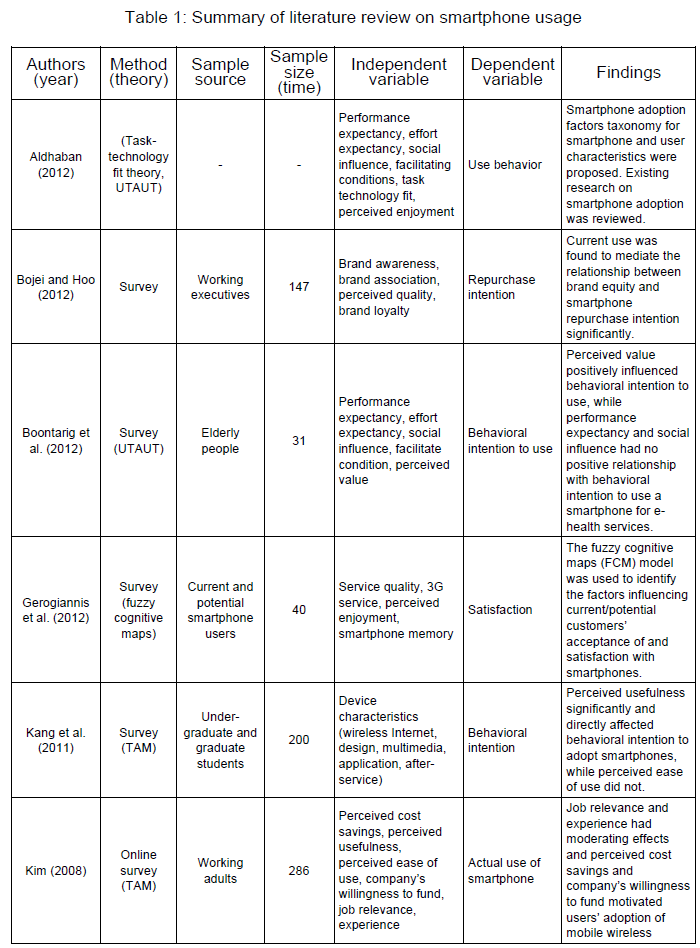 |
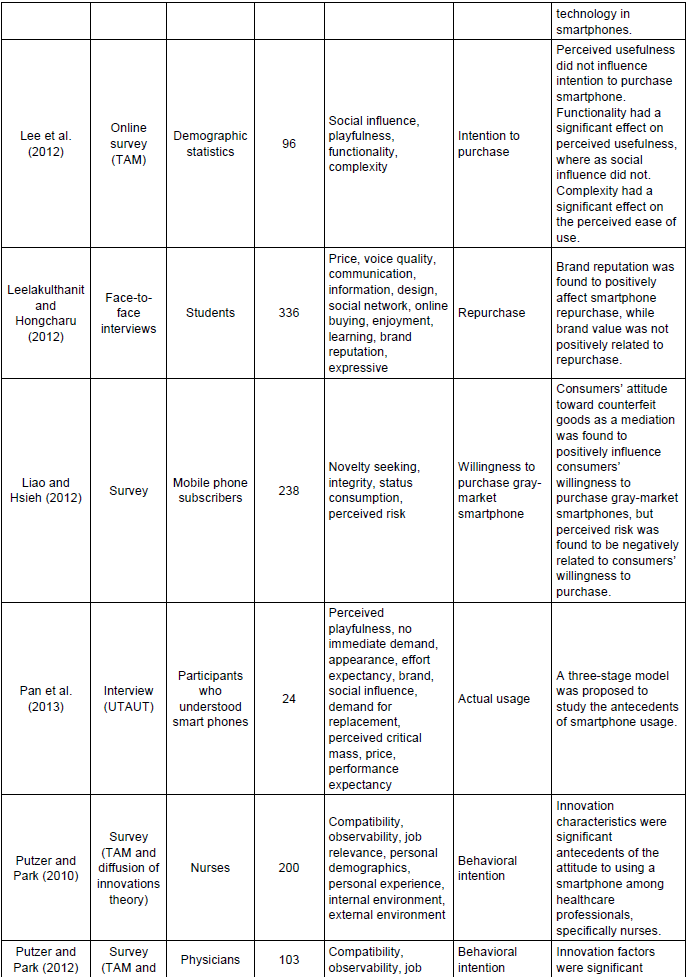 |
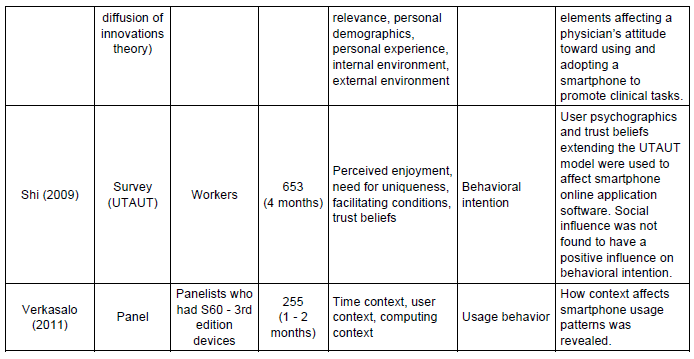 |
| However, among such diverse research work, only few studies have focused on users’ smartphone app usage patterns (e.g., Kang, 2014; Kim et al., 2013; Shi, 2009). For example, Shi (2009), realizing that downloading smartphone apps has become an important part of users’ everyday lives, investigated the factors influencing users’ intentions to adopt smartphone app software based on unified theory of acceptance and use of technology (UTAUT). These prior studies have contributed to the body of knowledge of smartphone usage by revealing that some factors such as easiness (Kang, 2014), important others’ opinion (Kang, 2014), social connection (Kang, 2014; Kim et al., 2013), enjoyment (Shi, 2009), and facilitating conditions (Shi, 2009) are significantly influencing users’ attitude and intention to use smartphone apps. However, they also have a limitation since all application types were considered the same without distinguishing between free and paid apps. By revealing different underlying motivations of those who purchase paid apps over other similar ones, including free apps, this study may provide plentiful implications for both academicians and managers. Thus, this paper is among the first attempts to examine key determinants of users’ intention to purchase paid apps. We propose a research model for paid smartphone apps that explains the role of paid app characteristics as well as the consumers’ personal and social characteristics. The research model is presented in Figure 1. |
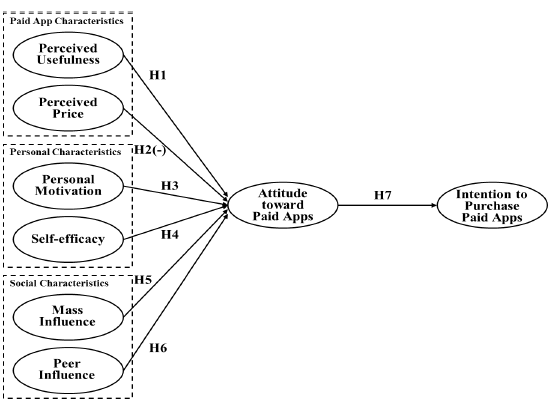 |
| Paid app characteristics |
| Generally, consumers intending to purchase a product or service consider factors such as its function (i.e., perceived usefulness or benefit), its price (i.e., price, cost, or risk), and its vendor’s fame (i.e., vendor or brand awareness) before deciding (Zo and Ramamurthy, 2009). In the case of paid smartphone apps, however, vendor or brand awareness is less important than the other factors since most paid apps are game, entertainment, and social networking apps and users pay little attention to who the provider is (Xu et al., 2011). We assume, therefore, that only perceived usefulness and perceived price of paid apps influence users’ attitude toward and intention to purchase paid apps. |
| Perceived usefulness, the value consumers detect in a product or service, has always been critical in new technology acceptance and adoption (e.g., Davis, 1989) as well as in research on consumers’ continuance intentions (e.g., Bhattacherjee, 2001). Davis (1989) found that users who believe an information system to be useful are more likely to have a better attitude toward it. Many extensive studies of smartphone adoption using the technology acceptance model (TAM) have also provided evidence regarding how much perceived usefulness significantly influences users’ attitude (e.g., Joo and Sang, 2013; Park et al., 2013). We can thus extrapolate that people who find a paid app to be useful in their daily lives will have better attitude toward it. We therefore propose the following hypothesis: |
| H1: Perceived usefulness will positively influence users’ attitude toward paid smartphone apps. |
| As a paid smartphone app is our research object, we must consider its cost. Perceived price, also referred to as perceived cost from the standpoint of the consumer, is user’s perception of the products’ price (Jacoby and Olson, 1977). Consumers often compare prices when making a purchase decision. Users who perceive the costs of using smartphone apps to be high will generally be reluctant to purchase them. Prior studies found that perceived price has a significant effect on users’ attitude toward and adoption of new technologies and services in the mobile banking (Luarn and Lin, 2005), mobile commerce (Wu and Wang, 2005), and multimedia messaging services environments (Lee et al., 2007). We thus propose the following hypothesis: |
| H2: Perceived price will negatively influence users’ attitude toward paid smartphone apps. |
| Personal characteristics |
| A number of studies have argued that consumers’ personal characteristics are important factors in the acceptance of new technologies or products (e.g., Amichai-Hamburger, 2002; Hills and Argyle, 2003). Lian and Lin (2008) claimed that understanding potential customers’ characteristics helps businesses succeed; they also discussed the relationship between consumers’ attitude and personal characteristics, whose constructs include the personal innovativeness of information technology (IT) (i.e., personality traits), self-efficacy, perceived security, product involvement, and privacy concerns about online shopping. Of these factors, self-efficacy would play a significant role in explaining users’ attitude toward and intention to purchase paid apps, as it is closely related to users’ belief in their ability to perform. In addition, given that the most frequently purchased apps are game and social networking ones (Xu et al., 2011), users’ intrinsic motivation, which includes the concepts of enjoyment and vitality, would be a critical factor in users’ personal characteristics (Ryan and Deci, 2000). |
| Intrinsic motivation, a perennial issue in the field of psychology, readily extends to economic interactions (Bénabou and Tirole, 2002), where it can represent “a principal source of enjoyment and vitality throughout life” (Ryan and Deci, 2000, p.70). An individual actuated by a high level of intrinsic motivation will engage in an activity more vigorously because it is felt to be interesting, pleasurable, or inherently satisfying in and of itself (Lin, 2007). Intrinsic motivation has been identified as a key determinant of attitude toward using IT (Hsu and Lin, 2008). Wu and Lu (2013) also emphasized that intrinsically motivated individuals will engage in an activity that maintains their own interests. Moreover, people are internally motivated to make decisions (i.e., purchasing smartphone apps) when such decisions give them pleasure or make them feel that what they have done is significant (Hsu and Lin, 2008). Thus, we propose the following hypothesis: |
| H3: Personal motivation will positively influence users’ attitude toward paid smartphone apps. |
| Self-efficacy, “the belief in one’s ability to organize and execute the action required to produce given attainments” (Bandura, 1977, p.3), has been confirmed as an important determinant in behavioral change (Kim et al., 2011; Wang et al., 2006); it has been cited frequently in IT-related studies, such as those on computer (e.g., Compeau and Higgins, 1995) and mobile self-efficacy (e.g., Keith et al., 2011). Self-efficacy is concerned with judgments about what people can do with their own skills rather than with the actual skills they have (Bandura, 1977). Research has shown a significant relationship between self-efficacy and users’ attitude toward certain types of IT (e.g., Kim et al., 2011; Wang et al., 2006); we can thus extrapolate that the higher the users’ self-efficacy, the better their attitude toward paid smartphone apps. We therefore hypothesize the following: |
| H4: Self-efficacy will positively influence users’ attitude toward paid smartphone apps. |
| Social characteristics |
| Social influence, “the person’s perception that most people who are important to him think he should or should not perform the new system” (Alawadhi and Morris, 2008, p.4), has emerged as an important antecedent in new technology usage (Bhattacherjee, 2000). Social influence theory also suggests that social culture and norms play important roles in communication groups (Kim et al., 2011). Some studies have considered social influence as the degree to which people perceive that important others believe they should use the new technology – commonly known as “peer influence” (Alawadhi and Morris, 2008; Kim et al., 2011). In fact, social influence involves not only peer influence but also the influence of other unfamiliar members of the social community. Therefore, social influence can be classified into external and internal types (Brancheau and Wetherbe, 1990). This study, following Brancheau and Wetherbe’s (1990) suggestion, considers peer (i.e., internal influence) and mass influence (i.e., external influence) as social determinants of users’ attitude toward paid apps. |
| Mass influence, which includes “mass media reports, expert opinions and other nonpersonal information” (Bhattacherjee, 2000, p.413), refers in this study to three smartphone app aspects: online reviews, ranking, and reputation. Mass influence is exerted by the information provided by anonymous paid app users. Many empirical studies of online consumer reviews have shown that they have a significant impact on consumers’ purchasing decisions (e.g., Zhu and Zhang, 2010). Purchasers of smartphone apps examine each app’s ranking and reputation to confirm its quality; better reviews, ranking, or reputation will lead to more favorable attitude. The following hypothesis is therefore proposed: |
| H5: Mass influence will positively influence users’ attitude toward paid smartphone apps. |
| Peer influence, exerted by important people, is a well-known factor in new information systems adoption (e.g., Bock et al., 2005) and sometimes replaces the social influence construct (Alawadhi and Morris, 2008). This paper considers it as the word-of-mouth influence of a potential user’s friends, colleagues, and superiors to distinguish it from mass influence. The influence of peers on users’ acceptance of new technologies and services has been widely confirmed (e.g., Alawadhi and Morris, 2008; Wei and Lu, 2014; Kim et al., 2011), though it was not shown to be positively related to intention to use ehealth services via smartphones (Boontarig et al., 2012). Thus, the following hypothesis is proposed: |
| H6: Peer influence will positively influence users’ attitude toward paid smartphone apps. |
| Relationship between users’ attitude and intention to purchase paid apps |
| Attitude is the psychological tendency to respond or act in ways determined by favorable or unfavorable evaluations and beliefs (Fishbein and Ajzen, 1975). Prior studies have suggested that factors such as perceived usefulness (Davis, 1989), perceived ease of use (Davis, 1989), playfulness (Moon and Kim, 2001), and perceived enjoyment (van der Heijden, 2003) influence behavioral intention through attitude. Most studies on TAM and UTAUT involving the acceptance of new technologies or services have shown a significant relationship between attitude and intention (e.g., Bhattacherjee, 2000; Kim et al., 2011). Therefore, we argue that users’ attitude toward paid smartphone apps is positively associated with users’ intention to purchase them. The following hypothesis is thus proposed: |
| H7: Users’ attitude toward paid smartphone apps will positively influence users’ intention to purchase them. |
METHODOLOGY |
| Measurements |
| We used a two-part questionnaire survey in order to examine the proposed research model. The first part’s questions measure the constructs pertaining to the research model, while the second part asks demographic questions about the participants. Table 2 presents the operational definitions of the constructs used in this study. To measure the constructs, we adapted items from previous studies that examined the same constructs in other research contexts. The instruments for perceived usefulness were adapted from Davis (1989), and the measurements for perceived price were developed from Chang and Wildt (1994). Items developed by Davis et al. (1992) were employed to measure personal motivation and items adapted from Wang et al. (2006) were used to measure self-efficacy. Peer influence was measured using three items adopted from Kim et al. (2011). As the mass influence construct lacks relative scales for measurement, we developed them as new items based on a definition of “external influence” (Brancheau and Wetherbe, 1990). Meanwhile, three items for each construct of attitude toward paid apps (von Watzdorf et al., 2010) and intention to purchase paid apps (Venkatesh et al., 2003) were used in the study. Each corresponding item was measured using a sevenpoint Likert scale, with answers ranging from 1 (“strongly disagree”) to 7 (“strongly agree”). Since the questionnaire items were written in English and the study was to be carried out in South Korea, it was necessary to translate them into Korean. After the questionnaire items were drafted, they were first sent to two academic professors for review, and were then revised according to their comments and suggestions, in order to make the wording of the items more precise and exact. |
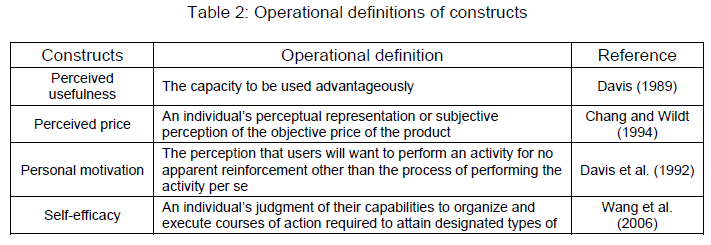 |
 |
| Data collection |
| The questionnaires were pre-tested through a pilot survey on 45 paid app users, undergraduate students at one of top universities in South Korea. The pre-test results provided reasonable assurance of the reliability and validity of the scale items. Appendix 1 lists the items used in the study. The main study was then conducted over a month in the autumn of 2013. The questionnaires were distributed to 237 undergraduate smartphone users. Six questionnaires with incomplete or inadequate answers were discarded, leaving 231 responses for the final analysis. |
| The sample consisted of 231 undergraduates, with 124 males and 107 females, ranging from 18 to 30 years old (for an average of 23.02). Table 3 presents the respondents’ demographic statistics and the information related to purchasing their apps. The results showed that 151 participants did not use paid apps, while 80 did. We also found that the most popular paid apps could be categorized into three types: entertainment apps (i.e., games, media, photos/background, sports, and music/audio), lifestyle apps (i.e., health, transportation, finance, weather/life, news/magazines, and social networking/communication), and education/business apps (i.e., education, ebooks/ reference materials, and business). |
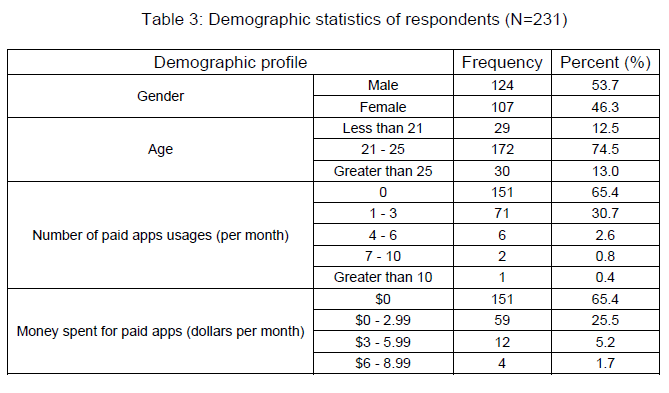 |
 |
| DATA ANALYSIS AND RESULTS |
| Measurement model |
| Statistical tests were conducted to evaluate the measurement model’s reliability, convergent validity, and discriminant validity. Variable reliabilities were estimated by calculating both the values of Cronbach’s alpha and composite reliability (CR) using IBM SPSS Statistics 20 and SmartPLS 2.0, respectively. Table 4 shows the results of reliability tests. The Cronbach’s alpha values range from 0.804 to 0.947 and the CR values range from 0.886 to 0.965, all of which are greater than an acceptable level of 0.70. The convergent validity of the model was examined with an exploratory factor analysis (EFA), along with the values of average variance extracted (AVE), which should be above 0.50. Appendix 2 presents all of the constructs’ inner factor loadings and cross-factor loadings. Based on both Table 4 and Appendix 2, we can see that all of the items have factor loadings higher than 0.70 and the items of each construct are under the same factor, which is considered significant. Moreover, the AVE values of all constructs were above the threshold value of 0.50, representing proper convergent validity. Finally, as Appendix 2 shows, it is apparent that all of the constructs are independent. In addition, as Table 5 shows, the diagonal elements, the square root of the AVE, are larger than the construct correlations, which are off-diagonal. Therefore, this model has adequate discriminant validity. |
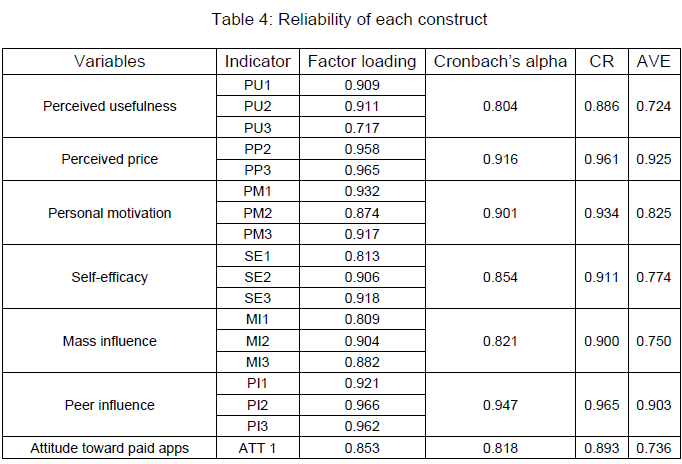 |
 |
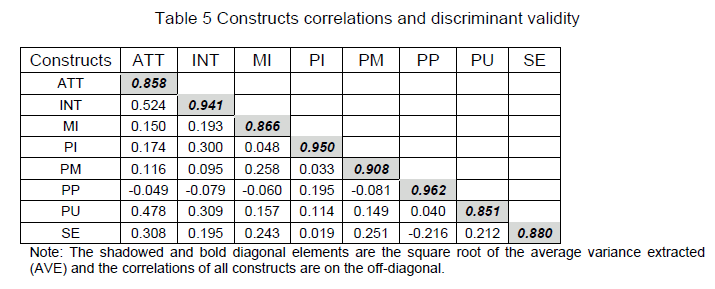 |
| Structural model |
| We used the structural equation modelling (SEM) technique using SmartPLS 2.0 in order to test the research model. Figure 2 presents the path coefficient and t-values of all hypotheses developed, along with explained endogenous variables’ (i.e., Attitude toward paid apps and Intention to purchase paid apps) variances (R2) for the structural model. Results shows four out of the seven hypotheses are supported (see Table 6). |
| Figure 2: Results of the structural model |
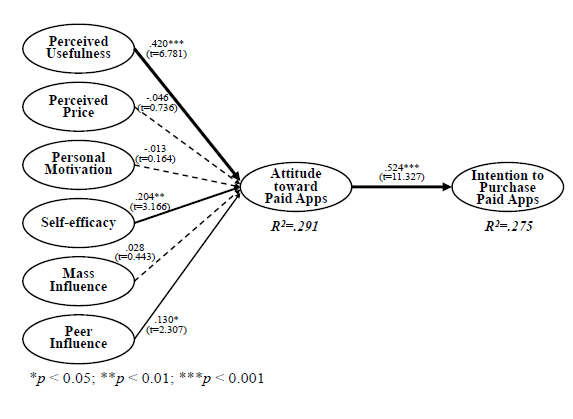 |
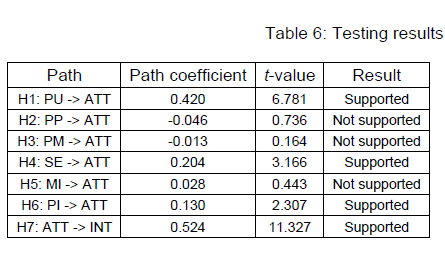 |
| As shown in Figure 2, four out of the seven hypotheses are supported. Concerning paid app characteristics, perceived usefulness has a significant impact on users’ attitude toward paid apps (path coefficient = 0.420; p < 0.001), supporting H1, while the antecedent role of perceived price is not supported. Regarding personal characteristics, personal motivation has no significant relationship with users’ attitude toward paid apps, rejecting H3. However, the result indicates that self-efficacy has a significant effect on users’ attitude (path coefficient = 0.204; p < 0.01), supporting H4. Concerning social characteristics, the result shows that mass influence has no significant relationship with users’ attitude, whereas peer influence positively impacts them (path coefficient = 0.130; p < 0.05), supporting H6. Finally, as expected, we found a strong positive relationship between users’ attitude and intention to purchase paid apps. Overall, six influencing factors explain approximately 29 percent (0.291) of the variance in attitude toward paid apps, and almost 28 percent (0.275) of the variance in intention to purchase paid apps is explained by users’ attitude. It is also worth noting that the effect of perceived usefulness (concerning paid app characteristics) is more salient than are other significant influencing factors, such as self-efficacy and peer influence, on consumers’ attitude and intention. |
DISCUSSION AND CONCLUSION |
| This study’s results imply that, among influencing factors, perceived usefulness, selfefficacy, and peer influence are the key determinants of users’ attitude toward and intention to purchase paid apps. Users have a more favorable attitude toward paid apps when (1) they believe that using them is useful in their daily lives; (2) they are confident about using them; and (3) people they know recommend using them. Moreover, more favorable attitude will lead to intention to purchase paid apps. These findings are confirmed by those of previous studies on perceived usefulness (Bhattacherjee and Sanford, 2006), self-efficacy (Wang et al., 2006), and peer influence (Kim et al., 2011) conducted in the context of IS or IT adoption. Further, the strong relationship between users’ attitude and intention has also been supported by the results of this study, consistent with those of previous studies employing theories such as TAM (e.g., Davis, 1989) and the theory of planned behavior (TPB) (e.g., Ajzen, 1991). |
| However, no significant relationships were found between users’ attitude and (1) perceived price, (2) personal intrinsic motivation, or (3) mass influence. Concerning perceived price, although people are more reluctant to purchase higher-priced apps, several studies have found this factor to be no longer important as a predictor of user behavior. For example, after carefully investigating perceived cost in the context of multimedia messaging services (MMS), Kim et al. (2011) concluded that perceived cost does not significantly influence attitude toward MMS usage because people pursuing higher-quality lifestyles are more likely to engage in entertainment and leisure activities, being less price sensitive. Similarly, users may feel less concerned about price when considering purchasing paid apps since most cost less than one U.S. dollar, as with MMS cases. The non-significant relationship between personal motivation and attitude may come from the diversity of paid app categories; there are many different types of apps and users, and linking users’ motivations to their attitude may no longer be appropriate without considering that differentiation. The finding in Teo et al. (1999) that perceived enjoyment as a personal motivator has an insignificant effect on the diversity of Internet usage supports our argument. Finally, unlike peer influence, the predictor of mass influence appears not to have a significant effect on users’ attitude: people care more about their direct interpersonal influences than about their indirect influences when considering using paid apps; this may explain why social commerce sites, which rely on the power of peer’s word-of-mouth, are becoming more popular. |
| In its theoretical implications, this study advances research on smartphone apps by identifying three influencing factors (i.e., paid app, personal, and social characteristics) in consumers’ attitude toward paid apps, which can lead to increased purchase intention. Few studies have explored the determinants of consumers’ attitude toward and behavior concerning smartphone apps. Even worse, most of them have failed to distinguish between free and paid ones. This study is one of the few attempts to investigate the determinants of consumers’ behavior around paid smartphone apps. Its research model provides new insights into consumer perceptions of paid smartphone apps, and its results should help researchers understand the concerns consumers have when deciding whether to purchase them. |
| The findings of this study advance our understanding of how and why consumers purchase paid smartphone apps by identifying the important factors in consumers’ intention to buy. The study’s implications are important not only to app developers but also to app merchants seeking better marketing strategies. Our findings indicate that perceived usefulness of paid apps is vitally important. Smartphone app developers should thus pay more attention to the quality and value of their products. Another result of this study shows that self-efficacy has a significantly positive effect on users’ attitude toward paid apps, suggesting that app developers should focus on ease of use issues. The results of this study also confirm the importance of peer influence in users’ attitude toward paid apps; app merchants should make effective use of word-of-mouth communications through social media such as social networking sites, online discussion forums, and blogs when promoting newly launched paid apps. |
| This study develops a model that determines consumers’ attitude toward and intention to purchase paid smartphone apps in terms of three aspects: paid app characteristics, personal characteristics, and social characteristics. The results imply that perceived usefulness, self-efficacy, and peer influence are the dominant determinants of users’ attitude and, in turn, positively influence intention to purchase. Despite its theoretical and practical implications, this study also has limitations. First, it has limited generalizability, as its sample comprises undergraduates from a single Korean university; the findings should thus be interpreted cautiously, and future studies should incorporate different combinations of respondents. Second, this study did not consider the differences among types of paid smartphone apps, of which there are many (e.g., finance, game, education, social networking). Different apps have different characteristics. Hence, future research should examine whether the type of paid apps affects the findings. |
ACKNOWLEDGMENTS |
| This work was supported by the Ajou University research fund. |
APPENDICES |
| Appendix 1. Measurement items NOTICE: Please think about a smartphone paid application that you are considering purchasing while answering the following questions. |
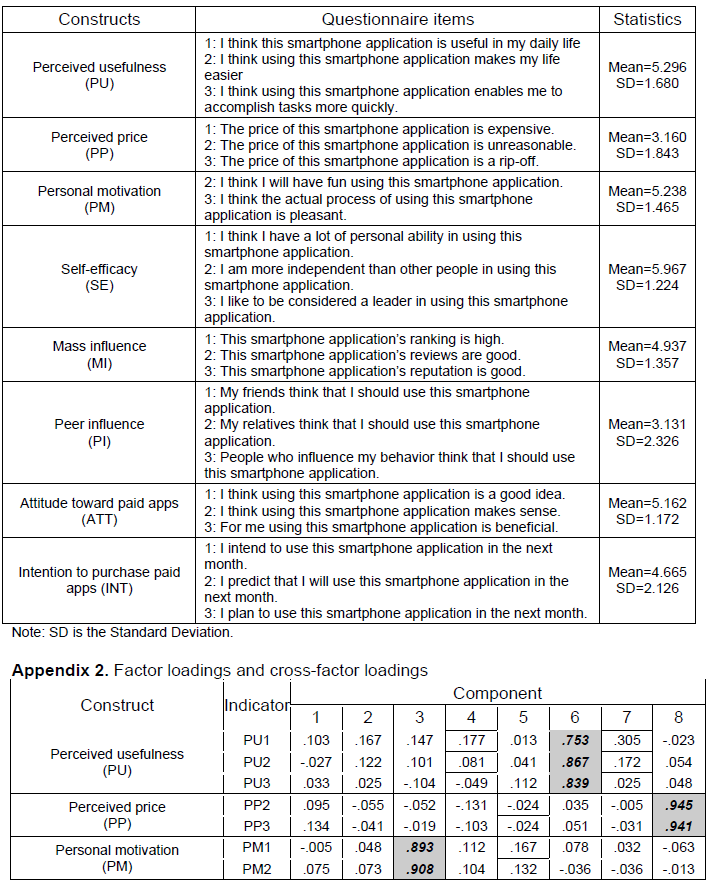 |
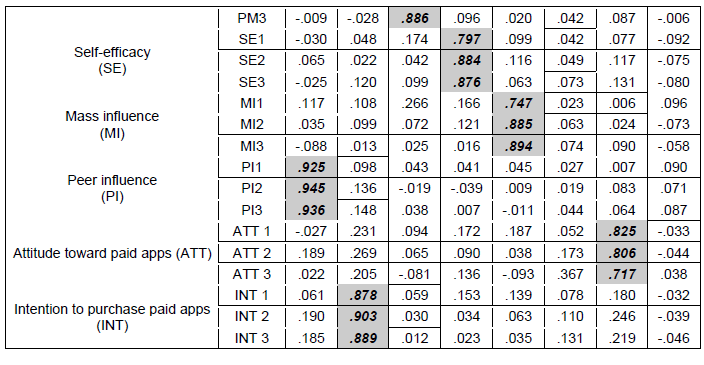 |
References |
|
Copyright © 2025 Research and Reviews, All Rights Reserved